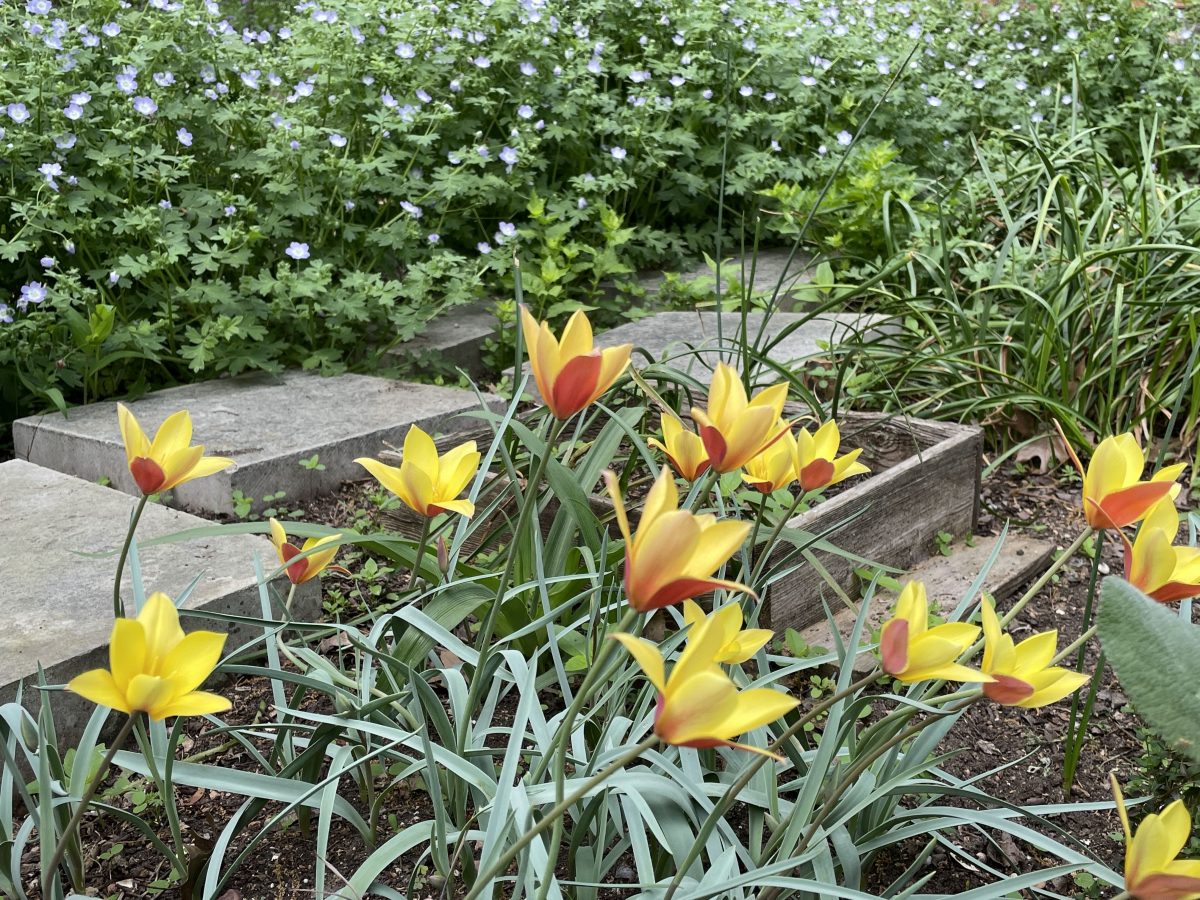Carol at May Dreams Gardens invites us to tell her what’s blooming in our gardens on the 15th of each month.
February 15, 2012
Well. If winter is the only season left for Austinites to garden in (the rest of the year being too hot), I’m glad this winter has been wet and warm in contrast to last year’s horrible dry and cold winter. I only had four things blooming last February and one of them was henbit. Zanthan Gardens is overrun with henbit this year but a lot of other nicer things, too.
The plants are very confused, though. They went semi-dormant in 2011’s hot, dry summer and then started putting out growth the second it began raining. So, while this February had a very lacksluster showing of paperwhite narcissus and the daffodil, tulips, bluebells, and summer snowflakes have not yet appeared, it is filled with roses. Roses blooming and roses putting out new canes.
The first rose to bloom was the hot weather trooper, ‘Blush Noisette’.

Then ‘Mermaid’ started blooming. It usually is my last rose to flower. I think of it as a late May, early June rose. Mermaid has the biggest flowers, flat flowers the size of saucers. It’s also the thorniest rose I grow. ‘Mermaid’ is a monster of a rose and not one that’s easily tamed.

Typically my first rose of the year is my favorite ‘Souvenir de la Malmaison’. I breathed a sigh of relief when it started putting out new canes. I was very close to losing it to cane dieback last fall. I cut back the bad canes and sprayed it with pruning paint. It did not look good. I’ve already lost half my roses to cane dieback so I was not optimistic. But it’s pulled through.

‘Souvenir de la Malmaison’ is one rose that doesn’t like wet weather. The flowers ball; that is, the outside petals of the blossoms stick together. I had about a dozen flowers that I had to peal the outside petals off of for them to open.

The ‘New Dawn’ rose along the front fence is blooming. The one in the back yard is not yet. It is about the same color as ‘Souvenir de la Malmaison’ but with a much more modern flower shape.

Now for the flowers which are blooming in season. The Mexican plum started blooming last week and is just starting to fill out this week. In my mind, the Mexican plums are the first to bloom, followed by redbuds for Valentine’s day, and then Texas mountain laurels. The latter has been blooming all over my neighborhood and downtown for a week. I still haven’t spotted my first redbud for 2012.

Flowers in the tradescantia family will start blooming with any spring rain. I’ve had false dayflowers bloom in December but February and March is more usual. So far, I have only this one in flower but the yard is covered with plants about to bloom.

Ditto its perennial cousin, the spiderwort.

For some reason, the larkspur began blooming before the bluebonnets. Usually my bluebonnets are in full bloom by mid-March and the larkspur take over in mid April. Several larkspur are already blooming and a lot more are soon to follow. Not a single bluebonnet (and there are quite a few plants) has sent up a flower stalk yet.

And then we have several flowers, like this salvia, that were blooming in fall, got some frost damage in December and died back slightly (but not all the way to the ground) and have made a comeback. Ruellia and lantana are also in this category.

In the vegetable garden the English peas are in full bloom and we’ve been eating peas, too. We pick lettuce and swiss chard almost every day. And the carrots are producing baby carrots. I hope they get a little bigger. The rosemary is still full of flowers.
Henbit has been very invasive this year. It’s just beginning to fade but the chickweed and goosegrass is coming on strong in its place. I hate them all.
Complete List for February 2012
The list of all plants flowering today, February 15th 2012, at Zanthan Gardens. If the flower was blooming in February in 2008 or 2009 I indicated that in parentheses. I don’t have a February list for 2010.
- Commelinantia anomala
- Consolida ambigua
- Lantana montevidensis (2008, 2009)
- Lonicera fragrantissima (2009, 2011)
- Pisum sativum (2009)
- Polanisia dodecandra, clammy weed (2009)
- Prunus mexicana (2008, 2009)
- potato vine
- rose ‘Blush Noisette’
- rose ‘Mermaid’
- rose ‘New Dawn’
- rose ‘Souvenir de la Malmaison’ (2009)
- rosemary (2008, 2009, 2011)
- Ruellia
- Salvia madrensis
- Setcreasea pallida (2009)
- Sophora secundiflora
- Tradescantia, spiderwort (2009)


























 2011-02-15. Lonicera fragrantissima (winter honeysuckle).
2011-02-15. Lonicera fragrantissima (winter honeysuckle).
 Scarlet milkweed, Asclepias curassavica
Scarlet milkweed, Asclepias curassavica


